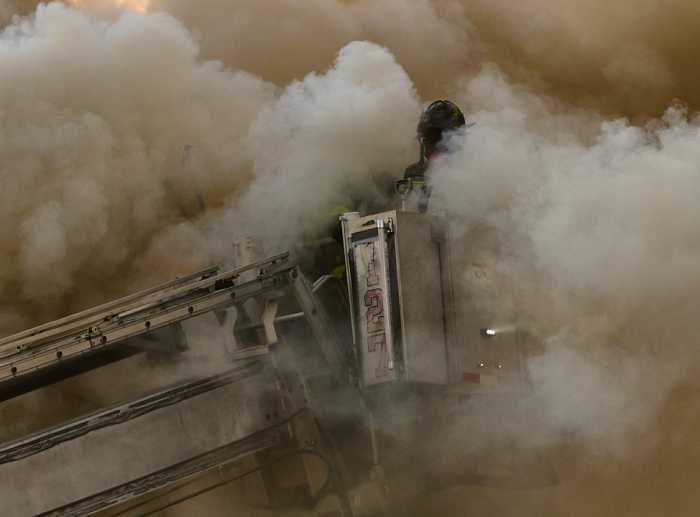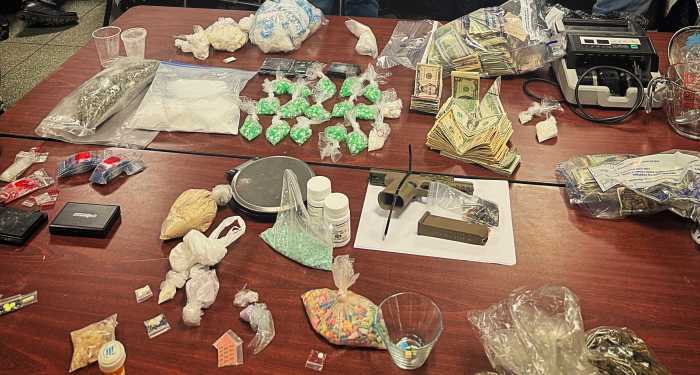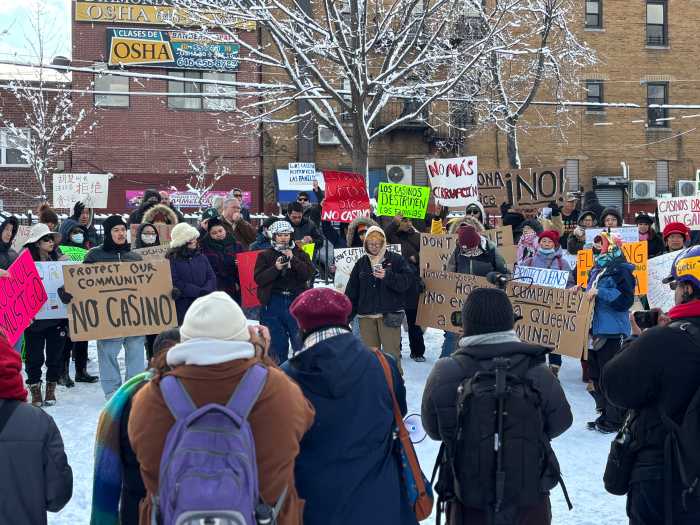With more than 1.1 million students in the New York City public school system, the demand for more seats in classrooms has significantly increased over the years to alleviate chronic overcrowding — especially in Queens, which has led the city in the number of schools at or over capacity.
Queens politicians and organizers have been advocating for the construction of new schools in the borough — particularly in Community School District (CSD) 24 which includes the neighborhoods of Maspeth, Ridgewood, Elmhurst, Corona, Middle Village, Glendale, Hunters Point and Long Island City.
The second most overcrowded school district in Queens, CSD 30, includes the neighborhoods of Queensbridge, Dutch Kills, Sunnyside, Woodside, Ravenswood, Astoria, Ditmars, Steinway, Jackson Heights and East Elmhurst.
“We still have hugely overcrowded schools and more than half a million students in New York City in overcrowded schools according to the DOE’s own statistics,” said Leonie Haimson, executive director of Class Size Matters, a nonprofit advocacy group that works toward implementing smaller classrooms in the city for almost 20 years. “We’ve moved backwards since then. Class sizes are much larger now since I began advocating.”
In its 2018 report on overcrowding highlighting CSD 24 as its case study, the City Council found that at the K-8 level, CSD 24 has a 118 percent utilization rate with overcrowding in 38 of 44 elementary and middle schools. There is a shortage of 6,599 seats and the highest enrollment of any school district with a capacity of 43,445 students.
In CSD 24, the overall district utilization rate is 94.5 percent with 22 overcrowded schools, according to the DOE’s Blue Book (2017-2018). The elementary utilization rate is at 97.4 percent and middle school utilization rate is at 87.8 percent.
Specifically, in Long Island City at P.S. 78, the utilization rate is at 109 percent and is already over capacity at 135 percent.
“More than 70 children who were zoned to the school were put on the waitlist for kindergarten last spring, while classes for numerous pre-K kids are being housed in trailers,” said Haimson.
The report also highlighted overcrowding in Queens CSD 25 and 26 — all at or above 115 percent capacity in 2014-2015 and CSD 28 at over 100 percent capacity.
There are various negative factors that can impact a child’s education in an overcrowded classroom, according to Haimson.
“Large classes diminishes children’s opportunity to learn and receive feedback from their teachers,” said Haimson. “Overcrowding also leads to a loss of art rooms, music rooms and science rooms … a lack of access to the gym, a lack of access to the cafeteria at reasonable periods for lunch, and a lack of dedicated space for special needs kids to get their services. There are multiple ways in which overcrowding diminishes and undermines the quality of education.”
According to Haimson, more funding is needed for smaller classes and construction of more schools rapidly and efficiently in Queens and throughout the city. The organization is also calling for more transparency in the school planning process.
“The issue of class sizes come up in every single borough town hall meeting that the mayor and chancellor has attended, and the mayor promised to reduce class sizes when he first transferred office and the chancellor admits that class size makes a huge difference,” said Haimson. “But they both make excuses and the chancellor then says we have to wait for more state funding and then they would give it to principals to do with it as they like, which is not a reasonable answer at all.”
Haimson continued, “They need to make it a priority and allocate specific funding towards class size reduction, and they need to accelerate and expand the capital plan to create more seats. It’s two of their biggest failures.”
Councilman Daniel Dromm, a representative of CSD 24 and former New York City public school teacher for over 20 years at P.S. 199 in Sunnyside, became an advocate for class size reduction after teaching in one of the most overcrowded schools in the city, he said.
“They had to make space in closets, locker rooms, dressing rooms and elsewhere,” said Dromm, chair of the City Council Finance Committee. “Class size reduction will help teachers provide instructional class lessons and the city has never tried class size reduction. With 34 kids in a classroom, they can’t spend as much time with each child.”
There is an additional need of 3,961 seats in CSD 24 and 490 seats in CSD 30, according to Dromm.
“We’ve had some success in reducing the number of seats needed in District 30, but not as much success in District 24 where it’s a mixed bag,” said Dromm. “There are successes in some areas and not in others. The Department of Education doesn’t take into account new developments in the city and the influx of immigrants in the community, such as Jackson Heights, Elmhurst and Astoria.”
Come September in CSD 30, P.S. 398Q will be opening its doors to students for the new school year with an additional 458 seats. Originally, the developer had plans to construct an apartment complex at the White Castle site located at 69-01 34th Ave. in Jackson Heights, said Dromm.
To tackle school overcrowding, the councilman has initiated using imminent domain for the good public purpose of building schools in highly overcrowded districts, he said.
Dromm, along with other politicians, would like to see the creation of special zoning districts to encourage school construction in high-need districts, which would require public review and a vote by the City Council.
Additionally, the group wants the city to explore new funding strategies to pay for future school construction, such as implementing impact fees on new developments that will bring more children into communities, and having developers whose projects create significant adverse impacts to public school pay into a school construction fund that would be set up by the city.
“It’s unfortunate that we still have classes with 30 to 34 students whereas in Westchester and Long Island the class size is 21, where kids are performing better and get more attention … and we need to improve on that,” said Dromm.
Meanwhile, Councilman Robert Holden has been searching for properties on Google Earth for construction of new schools in the northern parts of his district, he said.
“Maspeth and Woodside experience the most overcrowding, and we’ve been trying to find more locations for schools,” said Holden. “I was able to get one location at 69-02 [Queens Blvd.] where a developer wanted to put up two residential towers and he needed a zoning change on a small parcel in the back and I said I wouldn’t approve any development unless there’s a school.”
That development, Holden says, will bring 500 new seats for grades K-5 after the developer worked with the School Construction Authority.
“I also found another location, which is about less than a mile away that could possibly be a school or maybe even a high school because it’s large enough,” said Holden. “I’m still working on another school trying to get that to go into Cooper Avenue. It’s a District 75 school for special education.”
Additionally, Holden has helped with providing a gymnasium for P.S. 71, a new state-of-the-art cafeteria and kitchen at P.S./I.S. 87, and a stand-alone gymnasium and auditorium at P.S. 68. He is currently working on helping to assist with a gymnasium at P.S. 91, he said.
“All of the schools have needs and some of the schools present a challenge because P.S. 91 wants to keep their school yard, and the principal said they didn’t really like that idea, so we’re trying to find another solution,” said Holden. “When I first took office, I immediately started looking for school space and thankfully I found three locations within the first six months of taking office.”
Holden said it now depends on the SCA to work with the owner of the properties for a new school development.
In its proposed $17 billion FY 2020-2024 Five-Year Capital Plan, the DOE and SCA is working on bringing a total of over 5,000 high school seats in Queens by 2023 to alleviate school overcrowding, according to SCA President Lorraine Grillo.
“We’ve been working very hard in District 24, particularly in the areas of Corona and East Elmhurst,” said Grillo. “We’ve built hundreds and thousands of seats over there and we’ve been doing that over the last maybe five to 10 years to relieve the overcrowding in that area.”
According to Grillo, the SCA is currently working on three projects in Long Island City and they’re searching for another space in Court Square as well, she said.
“We have another intermediate school going up in Sunnyside in District 30 that really helps the LIC area and we’ve focused on that for years,” said Grillo. “I’m a Queens kid. I grew up in Astoria, grew up in District 30 and I know the area very well and what the needs are.”
In regards to class size reduction, Grillo said, there is a category within the capital plan.
“Those are for areas where the district may not be overcrowded, but a particular school may be remote from other schools and it is consistently overcrowded, so we try to go into those districts and relieve that problem,” said Grillo.
Since 2018, the SCA has created a new addition to P.S. 19 in Corona, three new locations for pre-K, and an annex at P.S. 143 in CSD 24. The SCA has five new upcoming projects opening through 2023 in CSD 24 and 30.
Overall, in Queens, the SCA is creating 1,600 seats in 2019; 2,432 seats in 2020; 3,902 seats in 2021; 2,997 seats in 2022; and 3,079 seats in 2023.
The FY 2020-2024 Capital Plan will fund the construction of 57,000 new seats in New York City – for a total of 83,000 seats between this plan and the prior, FY 2015-2019 Plan. There will be $550 million for early education initiatives, $150 million for class size reduction, and $180 million for removal of classroom trailers.



































